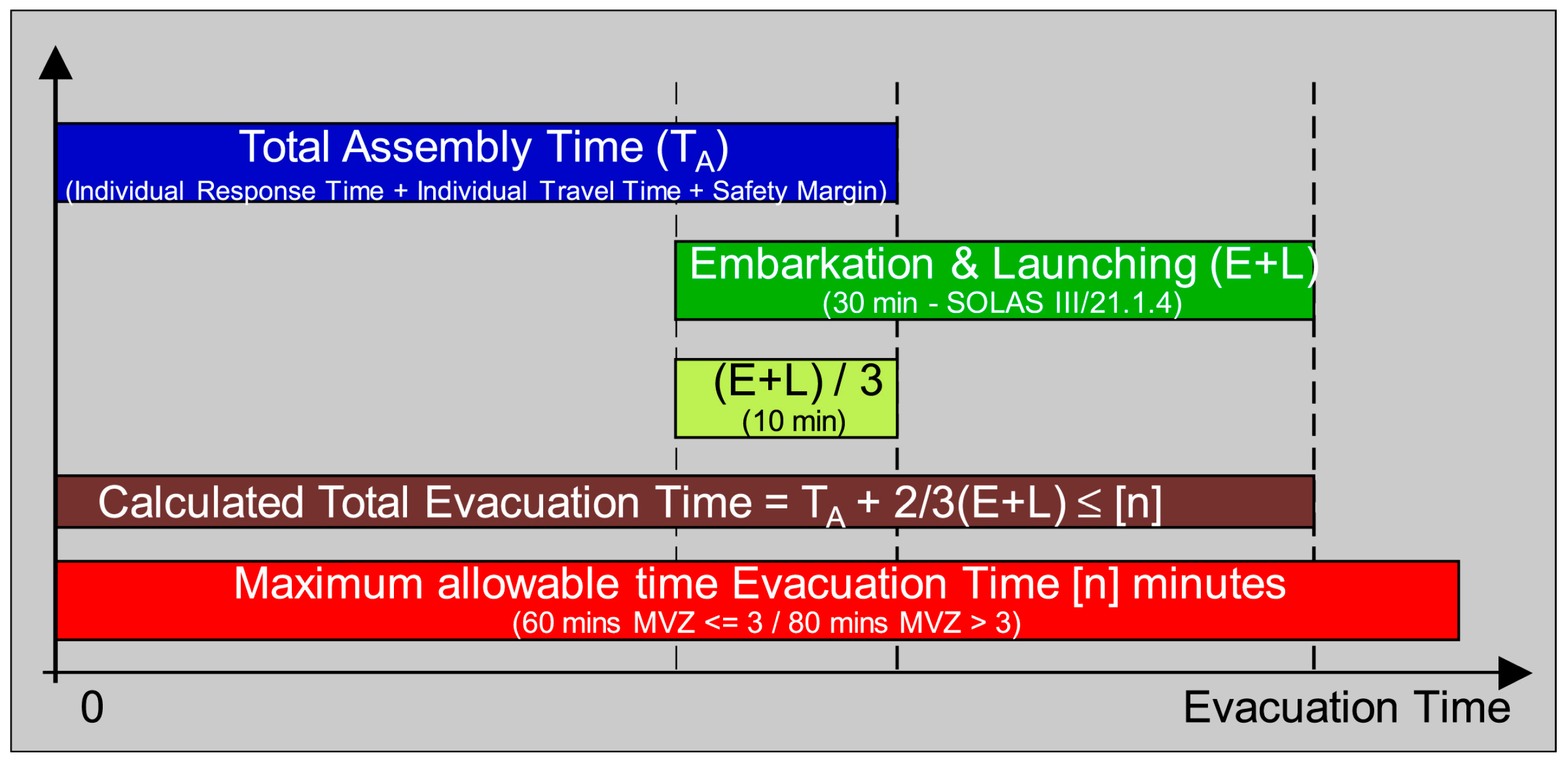
| Version | Summary | Created by | Modification | Content Size | Created at | Operation |
|---|---|---|---|---|---|---|
| 1 | Evangelos Stefanou | -- | 1939 | 2024-02-22 14:25:43 | | | |
| 2 | Evangelos Stefanou | Meta information modification | 1939 | 2024-02-22 14:40:24 | | | | |
| 3 | Jessie Wu | Meta information modification | 1939 | 2024-02-23 03:14:03 | | |
Video Upload Options
Within the expansive domain of maritime safety, optimizing evacuation procedures stands as a critical endeavour. After all, evacuation is literally the last and fundamental safety level afforded to mariners and passengers.
1. Introduction
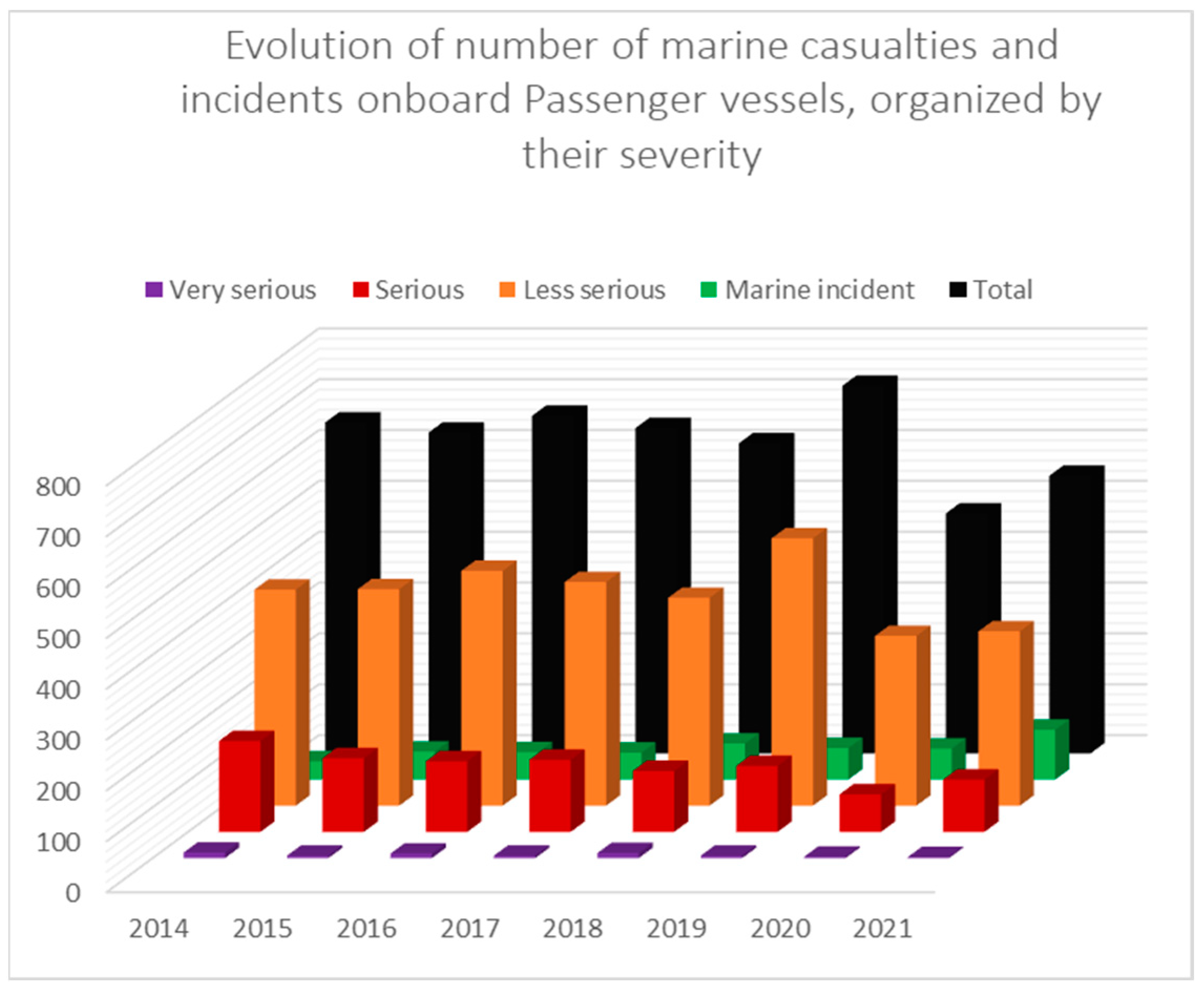
2. Regulatory Framework
3. Evacuation Procedure
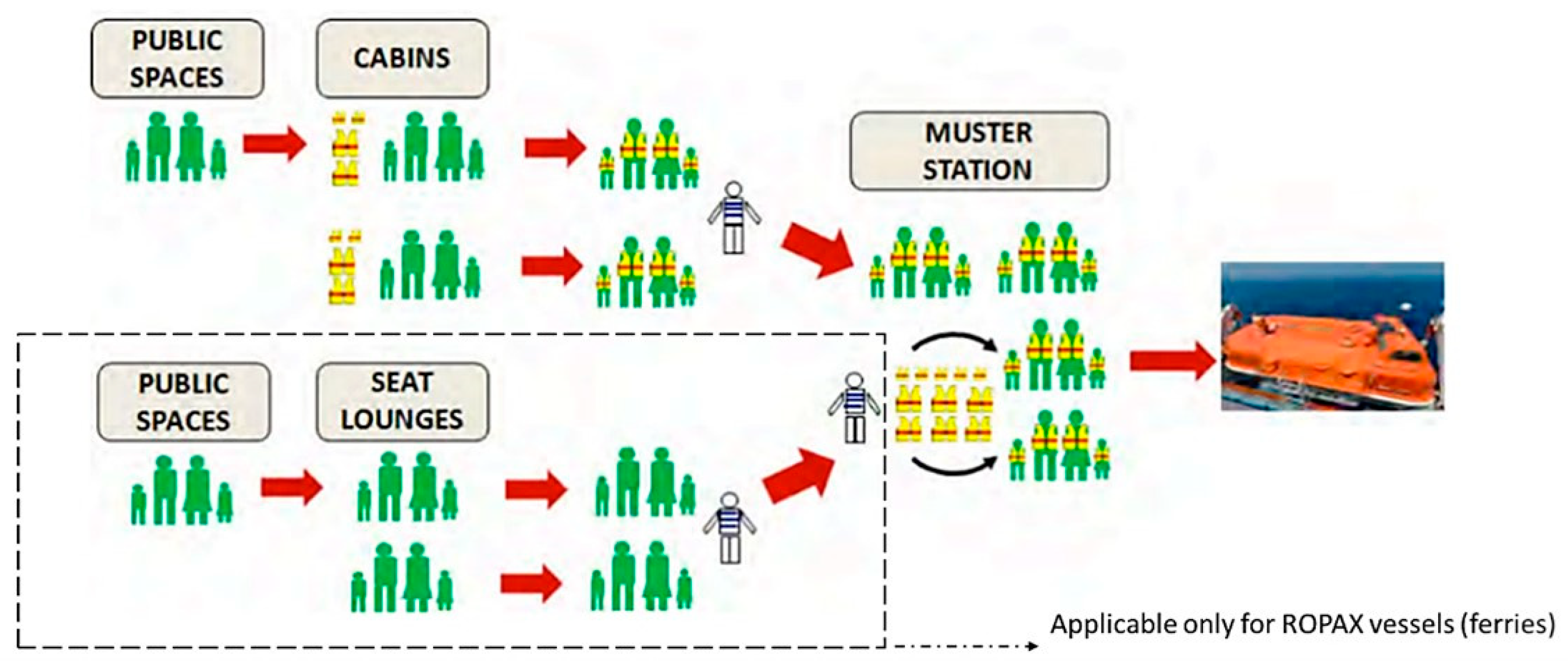
4. Evacuability
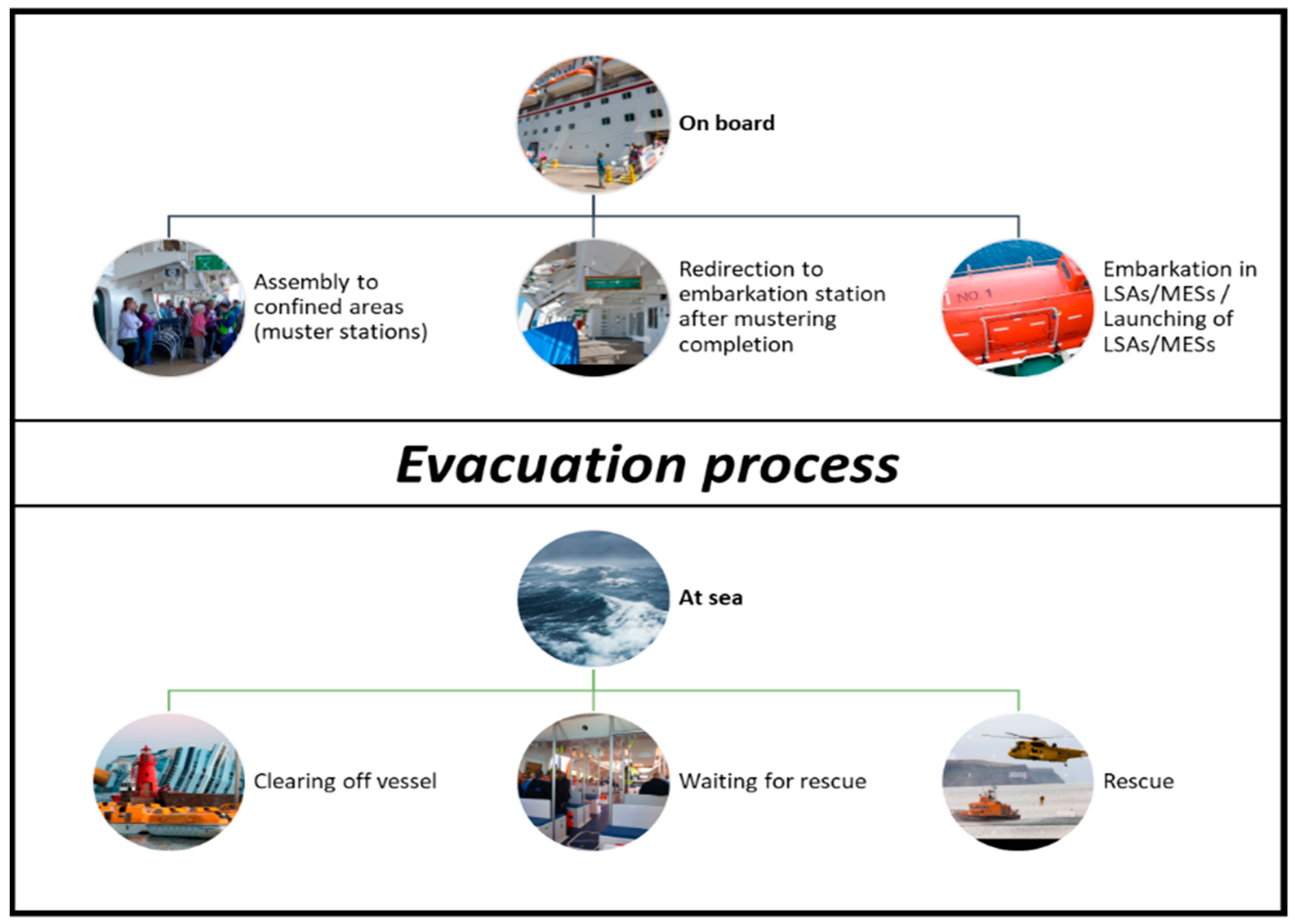
5. Time-Domain Simulation Tools
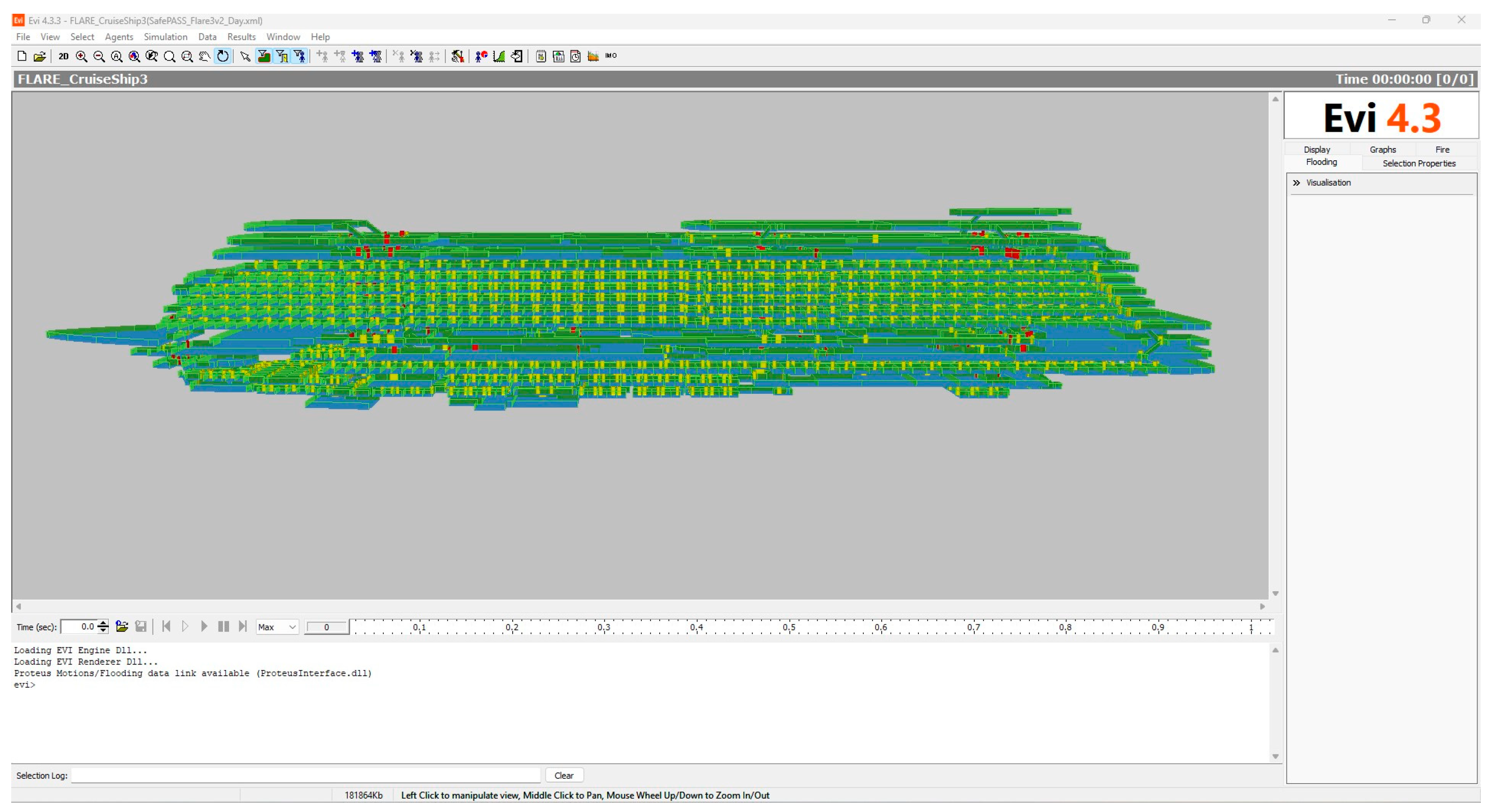
6. Evacuation improvements
Given the challenges identified in traditional evacuation procedures amid severe weather conditions, it is clear that innovative approaches are indispensable for enhancing the safety and efficiency of evacuations on large passenger vessels.
Leveraging insights from the SafePASS project, innovative solutions have been developed, utilizing smart devices and augmented reality to revolutionize marine emergency response and vessel evacuation. Real-time risk metrics and a common operational picture (COP) provided by these solutions enhance crew training, offer personalized evacuation instructions, and improve decision-makers’ situational awareness throughout all evacuation stages.
These solutions cover all evacuation stages, from alarm to rescue, promising tangible improvements in safety and efficiency, irrespective of hazards, weather conditions, or passenger demographics. Most precisely, they encompass various components, including a core engine, common operational picture, next-generation life-saving appliances (LSAs), ship layout alterations, indoor localization sensors, and integration of smart components such as dynamic exit signs, smart wristbands, passenger chatbots, passenger mobile applications, and smart lifejackets. Additionally, crowd dynamic simulators and risk modeling tool have been developed to further enhance evacuation procedures.
Additionally, conventional port evacuation procedures (when the vessel is moored at port) following the International Security Management (ISM) code may not always be suitable, leading to concerns about prolonged evacuation times. Modified procedures onboard passenger vessels aim to streamline evacuation processes and minimize response times, especially in port scenarios.
In conclusion, the integration of cutting-edge technological solutions and the refinements of the evacuation procedures enhance the safety, efficiency, and effectiveness of evacuations on large passenger vessels under various scenarios, ensuring swifter, smarter, and more secure outcomes.
References
- Stefanidis, F.; Boulougouris, E.; Vassalos, D. Modern Trends in Ship Evacuation. In Proceedings of the Sustainable and Safe Passenger Ships Conference, Piraeus, Greece, 4 March 2020.
- Ventikos, N.P.; Sotiralis, P.; Annetis, M.; Podimatas, V.C.; Boulougouris, E.; Stefanidis, F.; Chatzinikolaou, S.; Maccari, A. The Development and Demonstration of an Enhanced Risk Model for the Evacuation Process of Large Passenger Vessels. J. Mar. Sci. Eng. 2023, 11, 84.
- European Maritime Safety Agency. Emsa Annual Overview of Marine Casualties And Incidents 2022; European Maritime Safety Agency: Lisbon, Portugal, 2022.
- Ratzan Weissman & Boldt Cruise Ship Accidents and Their Most Frequent Causes. Available online: https://www.rwblawyers.com/news/cruise-ship-accidents-and-their-most-frequent-causes#:~:text=According%20to%20the%20Maritime%20Injury,died%20in%20cruise%20ship%20accidents (accessed on 31 October 2023).
- Nasso, C.; Bertagna, S.; Mauro, F.; Marinò, A.; Bucci, V. Simplified and Advanced Approaches for Evacuation Analysis of Passenger Ships in the Early Stage of Design. Brodogradnja 2019, 70, 43–59.
- Boulougouris, E.; Papanikolaou, A. Modeling and Simulation of the Evacuation Process of Passenger Ships. In Proceedings of the 10th International Congress of The International Maritime Association of the Mediterranean, Crete, Greece, 14–17 May 2002.
- Guarin, L.; Hifi, Y.; Vassalos, D. Passenger Ship Evacuation—Design and Verification. In Virtual, Augmented and Mixed Reality: Applications of Virtual and Augmented Reality, Proceedings of the 6th International Conference, VAMR 2014, Held as Part of HCI International 2014, Heraklion, Crete, Greece, 22–27 June 2014; Springer International Publishing: Berlin/Heidelberg, Germany, 2014; pp. 354–365.
- Vassalos, D.; Paterson, D.; Mauro, F.; Mujeeb-Ahmed, M.P.; Boulougouris, E. Process, Methods and Tools for Ship Damage Stability and Flooding Risk Assessment. Ocean. Eng. 2022, 266, 3062.
- Monalisa Eu Project Monalisa 2.0-Mass Evacuation in Ports Pilot Exercise. 2016. Available online: https://stm-stmvalidation.s3.eu-west-1.amazonaws.com/uploads/20160420145624/ML2-D4.1.2-Mass-Evacuation-in-Ports-Pilot-Exercise.pdf (accessed on 7 December 2023).
- Chouliaras, M.S. Introduction to Evacuation. 2015. Available online: https://www.scribd.com/document/427057532/pot-evac-pdf (accessed on 7 December 2023).
- Balakhontceva, M.; Karbovskii, V.; Rybokonenko, D.; Boukhanovsky, A. Multi-Agent Simulation of Passenger Evacuation Considering Ship Motions. Procedia Comput. Sci. 2015, 66, 140–149.
- Gwynne, S.; Galea, E.R.; Lyster, C.; Glen, I. Analysing the Evacuation Procedures Employed on a Thames Passenger Boat Using the MaritimeEXODUS Evacuation Model; Springer: Berlin/Heidelberg, Germany, 2003; Volume 39.
- Park, J.H.; Lee, D.; Kim, H.; Yang, Y.S. Development of Evacuation Model for Human Safety in Maritime Casualty. Ocean. Eng. 2004, 31, 1537–1547.
- Klüpfel, H.; Schreckenberg, M.; Meyer-König, T.; Klüpfel, H.; Schreckenberg, M. Assessment and Analysis of Evacuation Processes on Passenger Ships by Microscopic Simulation. In Proceedings of the Pedestrian and Evacuation Dynamics, Berlin, Germany, 12 January 2002.
- Meyer-König, T.; Valanto, P.; Povel, D. Implementing Ship Motion in AENEAS—Model Development and First Results. In Pedestrian and Evacuation Dynamics 2005; Springer: Berlin/Heidelberg, Germany, 2005; pp. 429–441.
- Stefanidis, F.; Boulougouris, E.; Vassalos, D. Ship Evacuation and Emergency Response Trends. In Proceedings of the Design and Operation of Passenger Ships, London, UK, 30 April–1 May 2019.
- Drager, K.; Orset, S. Evac—The Mustering and Evacuation Computer Model Resulting from the Brite-Euram Project Mepdesign; Pedestrian and Evacuation Dynamics: Duisburg, Germany, 2001; pp. 355–368.
- Vassalos, D.; Guarin, L.; Vassalos, G.C.; Bole, M.; Kim, H.S.; Majumder, J. Advanced Evacuation Analysis—Testing the Ground on Ships. In Proceedings of the 2nd International Conference on Pedestrian and Evacuation Dynamics, Greenwich, UK, 20–22 August 2003.
- Jasionowski, A. An Integrated Approach to Damage Ship Survivability Assessment. Ph.D. Thesis, University of Strathclyde, Glasgow, UK, 2001.
- Evi, version 4.3.3. Software for Ship Evacuation. Safety At Sea: Glasgow, UK, 2017.
- EC SAFEGUARD, EC-FUNDED Project under FP 7. 2013. Available online: https://ca.practicallaw.thomsonreuters.com/9-381-1530?transitionType=Default&contextData=(sc.Default)&firstPage=true (accessed on 7 December 2023).
- Guarin, L.E.; Shigunov, V.; Vassalos, D.; Guarin, L.; Majumder, J.; Vassalos, G. Fire and Flooding Risk Assessment in Ship Design for Ease of Evacuation. In Proceedings of the 2nd International Conference on Design for Safety, Osaka, Japan, 27–30 October 2004.
- Dogliani, M.; Vassalos, D.; Strang, T. A New Concept to Boost Passenger Evacuation Effectiveness in the Cruise Industry. In Proceedings of the 3rd International Euro-Conference on Computer Applications and Information Technology in the Marine Industries (COMPIT), Parador Siguenza, Spain, 9–12 May 2004.
- Tsychkova, E. Influence of Waves and Ship Motions on Safe Evacuation of Passenger Ships. Ph.D. Thesis, Kungliga Tekniska Högskolan (KTH), Stockholm, Sweden, 2000.


